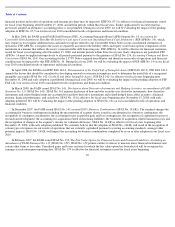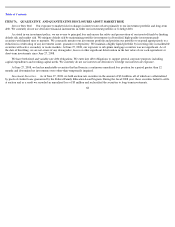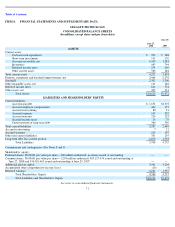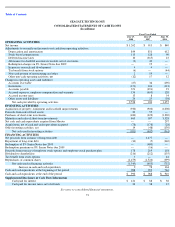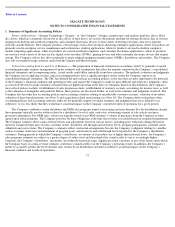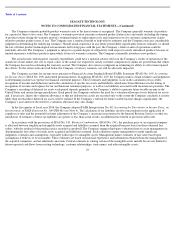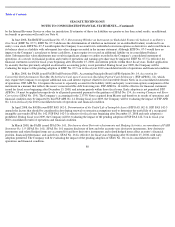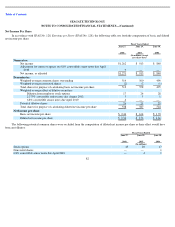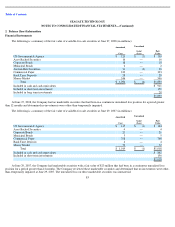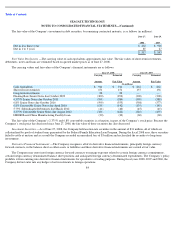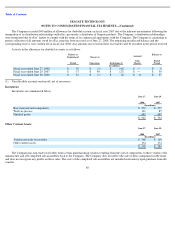Seagate 2007 Annual Report Download - page 77
Download and view the complete annual report
Please find page 77 of the 2007 Seagate annual report below. You can navigate through the pages in the report by either clicking on the pages listed below, or by using the keyword search tool below to find specific information within the annual report.
Table of Contents
SEAGATE TECHNOLOGY
NOTES TO CONSOLIDATED FINANCIAL STATEMENTS
—
(
Continued)
The Company estimates probable product warranty costs at the time revenue is recognized. The Company generally warrants its products
for a period of three to five years. The Company’s warranty provision considers estimated product failure rates and trends (including the timing
of product returns during the warranty periods), estimated repair or replacement costs and estimated costs for customer compensatory claims
related to product quality issues, if any. The Company uses a statistical model to help with its estimates and the Company exercises considerable
judgment in determining the underlying estimates. Should actual experience in any future period differ significantly from its estimates, or should
the rate of future product technological advancements fail to keep pace with the past, the Company’s future results of operations could be
materially affected. The Company’s judgment is subject to a greater degree of subjectivity with respect to newly introduced products because of
limited experience with those products upon which to base its warranty estimates. The Company continually introduces new products.
The actual results with regard to warranty expenditures could have a material adverse effect on the Company’s results of operations if the
actual rate of unit failure, the cost to repair a unit, or the actual cost required to satisfy customer compensatory claims are greater than that which
the Company has used in estimating the warranty accrual. The Company also exercises judgment in estimating its ability to sell certain repaired
disc drives. To the extent such sales fall below the Company’s forecast, warranty cost will be adversely impacted.
The Company accounts for income taxes pursuant to Financial Account Standards Board (FASB) Statement (SFAS) No. 109, Accounting
for Income Taxes
(SFAS No. 109) and related pronouncements. In applying SFAS No. 109, the Company makes certain estimates and judgments
in determining income tax expense for financial statement purposes. These estimates and judgments occur in the calculation of tax credits,
recognition of income and deductions and in the calculation of specific tax assets and liabilities, which arise from differences in the timing of
recognition of revenue and expense for tax and financial statement purposes, as well as tax liabilities associated with uncertain tax positions. The
Company’s recording of deferred tax assets each period depends primarily on the Company’s ability to generate future taxable income in the
United States and certain foreign jurisdictions. Each period, the Company evaluates the need for a valuation allowance for its deferred tax assets
and, if necessary, adjusts the valuation allowance so that net deferred tax assets are recorded only to the extent the Company concludes it is more
likely than not that these deferred tax assets will be realized. If the Company’s outlook for future taxable income changes significantly, the
Company’s assessment of the need for a valuation allowance may also change.
In the first quarter of fiscal year 2008, the Company adopted FASB Interpretation No. 48, Accounting for Uncertainty in Income Taxes, an
Interpretation of FASB Statement No. 109
(FIN 48) (see Note 4). The calculation of tax liabilities involves uncertainties in the application of
complex tax rules and the potential for future adjustment of the Company’s uncertain tax positions by the Internal Revenue Service or other tax
jurisdiction. If estimates of these tax liabilities are greater or less than actual results, an additional tax benefit or provision will result.
In accordance with the provisions of SFAS No. 141, Business Combinations (SFAS No. 141), the purchase price of an acquired company
is allocated between tangible and intangible assets acquired and liabilities assumed from the acquired business based on their estimated fair
values, with the residual of the purchase price recorded as goodwill. The Company engages third-party valuation firms to assist management in
determining the fair values of certain assets acquired and liabilities assumed. Such valuations require management to make significant
judgments, estimates and assumptions, especially with respect to intangible assets. Management makes estimates of fair value based upon
assumptions it believes to be reasonable. These estimates are based on historical experience and information obtained from the management of
the acquired companies, and are inherently uncertain. Critical estimates in valuing certain of the intangible assets include but are not limited to:
future expected cash flows from existing technology, customer relationships, trade names, and other intangible assets;
76


